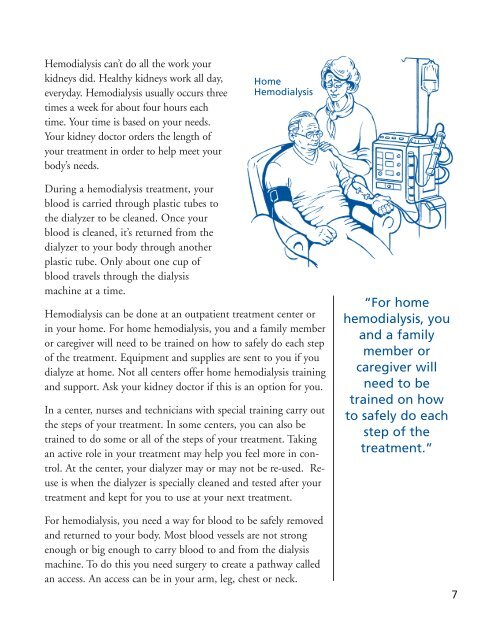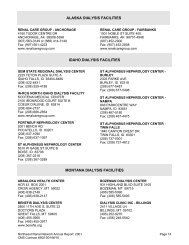Medicare's "You Can Live: Your Guide For Living With Kidney Failure"
Medicare's "You Can Live: Your Guide For Living With Kidney Failure"
Medicare's "You Can Live: Your Guide For Living With Kidney Failure"
- No tags were found...
You also want an ePaper? Increase the reach of your titles
YUMPU automatically turns print PDFs into web optimized ePapers that Google loves.
Hemodialysis can’t do all the work yourkidneys did. Healthy kidneys work all day,everyday. Hemodialysis usually occurs threetimes a week for about four hours eachtime. <strong>You</strong>r time is based on your needs.<strong>You</strong>r kidney doctor orders the length ofyour treatment in order to help meet yourbody’s needs.HomeHemodialysisDuring a hemodialysis treatment, yourblood is carried through plastic tubes tothe dialyzer to be cleaned. Once yourblood is cleaned, it’s returned from thedialyzer to your body through anotherplastic tube. Only about one cup ofblood travels through the dialysismachine at a time.Hemodialysis can be done at an outpatient treatment center orin your home. <strong>For</strong> home hemodialysis, you and a family memberor caregiver will need to be trained on how to safely do each stepof the treatment. Equipment and supplies are sent to you if youdialyze at home. Not all centers offer home hemodialysis trainingand support. Ask your kidney doctor if this is an option for you.In a center, nurses and technicians with special training carry outthe steps of your treatment. In some centers, you can also betrained to do some or all of the steps of your treatment. Takingan active role in your treatment may help you feel more in control.At the center, your dialyzer may or may not be re-used. Reuseis when the dialyzer is specially cleaned and tested after yourtreatment and kept for you to use at your next treatment.<strong>For</strong> hemodialysis, you need a way for blood to be safely removedand returned to your body. Most blood vessels are not strongenough or big enough to carry blood to and from the dialysismachine. To do this you need surgery to create a pathway calledan access. An access can be in your arm, leg, chest or neck.“<strong>For</strong> homehemodialysis, youand a familymember orcaregiver willneed to betrained on howto safely do eachstep of thetreatment.”7











